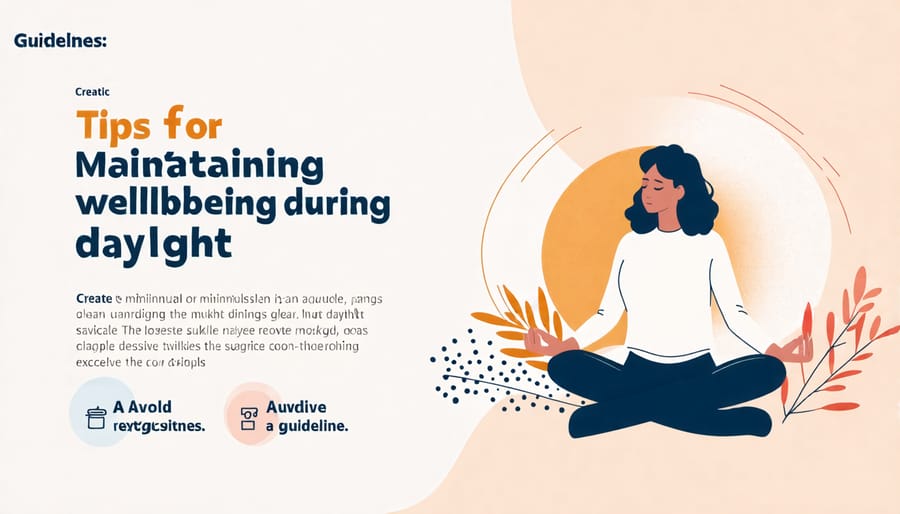Adjust your sleep schedule gradually before daylight savings to minimize its disruption. Prioritize exposure to natural light in the morning to help reset your circadian rhythm and enhance alertness. Maintain consistent bedtimes and wake-up times to promote better sleep quality and reduced stress levels. Incorporate regular physical activity, like a brisk walk outdoors, to boost mood and energy levels, crucial in adapting to the time change.

Understanding Daylight Savings Time
Daylight Savings Time (DST) has its roots in the early 20th century, primarily introduced during World War I to conserve energy by making better use of daylight. While the practice aimed to reduce reliance on artificial lighting and thereby save fuel, its effectiveness in modern times remains debatable. In Canada, most regions observe DST, which involves setting clocks ahead by one hour in the spring and reverting them in the fall. This shift can disrupt our internal body clocks or circadian rhythms, affecting our overall health.
Canadians may experience short-term consequences such as sleep disturbances and reduced productivity post-DST change. These disruptions can lead to elevated stress levels and have been linked to a temporary increase in heart attack risk, highlighting the importance of understanding and addressing its impacts on health and wellness. Moreover, changes in evening daylight can interfere with the body’s production of melatonin, a hormone essential for regulating sleep.
To mitigate these effects, Canadians are encouraged to gradually adjust their sleep schedules ahead of the time change, ensuring adequate rest in the days leading up to it. Staying consistent with sleep-wake routines and maximizing exposure to natural light during the day can further help ease the transition. By understanding DST’s impact, we can better prepare our minds and bodies, fostering improved mental health and well-being across the nation.
Impact of Daylight Savings on Mental Health
The Role of Circadian Rhythms
Daylight Saving Time (DST) can significantly affect our circadian rhythms, the internal clock that regulates our sleep-wake cycle. When the clocks spring forward or fall back, this sudden one-hour shift can disrupt our body’s routine, impacting our mental health and overall well-being. These rhythms are deeply intertwined with various bodily functions, including hormone production, sleep patterns, and alertness levels. A disruption can lead to issues such as mood swings, irritability, and even increased stress levels. For some, especially those already dealing with mental health challenges, the shift can exacerbate symptoms of depression and anxiety.
It’s crucial to mitigate these effects to maintain optimal health. Gradually adjusting your bedtime a few days before the change can help align your body clock. Ensure you spend some time in natural light during the day to help reset your circadian rhythm. Incorporating relaxation techniques, such as meditation or deep breathing, can also support mental resilience during this transition. Prioritizing these strategies can help Canadians maintain balance and well-being through the shift in daylight hours.

Potential Effects on Mood
Research indicates that daylight saving time (DST) can significantly impact mood, particularly when it comes to seasonal affective disorder (SAD). This condition is a type of depression that occurs at specific times of the year, often coinciding with reduced daylight during the fall and winter months. The abrupt shift in time can disrupt your circadian rhythm, the internal clock regulating various bodily functions, including sleep and mood. This disruption may lead to increased feelings of sadness, lethargy, and irritability.
It’s crucial to be proactive in managing these effects. One practical approach is to maximize exposure to natural light during the day, which can help balance your internal clock. Taking regular walks outside, especially during daylight hours, can boost serotonin levels and improve mood. Additionally, maintaining a consistent sleep schedule can also counteract the negative mood impacts of DST. Incorporate these small lifestyle adjustments to help navigate the mood challenges associated with the time change and support your overall mental well-being.
Daylight Savings and Physical Health
Sleep and Circadian Disruption
Daylight savings time (DST) can significantly disrupt sleep patterns and circadian rhythms, which are vital to maintaining our overall health. The transition in and out of DST is linked to reduced sleep duration and poorer sleep quality, primarily due to the sudden shift in the time people are used to waking up and going to bed. This disruption can lead to sleep deprivation, a condition associated with increased stress, mood swings, and impaired cognitive performance. For Canadians focusing on health and wellness, understanding and addressing these effects is crucial.
Sleep deprivation not only affects mental health by increasing the risk of anxiety and depression but also has physical health implications, including a weakened immune system and higher likelihood of developing chronic conditions such as obesity and cardiovascular disease. Staying proactive during this period by gradually adjusting sleep schedules a few days before the time change can help mitigate these effects. Engaging in relaxing activities before bedtime, and reducing screen time can further ease the transition. Prioritizing sleep during such periods supports maintaining a balanced circadian rhythm, contributing to better mental and physical well-being.
Cardiovascular Concerns
Research indicates a troubling link between the time shift of daylight savings and an increased risk of cardiovascular issues, particularly heart attacks. Studies suggest that losing an hour of sleep disrupts our body’s natural rhythm, leading to heightened stress and inflammation. This can exacerbate underlying health conditions and may trigger heart problems, especially in those already at risk. To mitigate these effects, Canadians are encouraged to adopt heart-healthy habits such as maintaining a consistent sleep schedule, managing stress through activities like meditation or exercise, and ensuring a balanced diet rich in fruits, vegetables, and whole grains. Understanding these risks helps guide proactive steps towards better heart health.
Increased Accident Risks
Research highlights a notable increase in road accidents and workplace injuries during daylight saving time transitions. This rise is largely attributed to disrupted sleep patterns and decreased alertness. Studies indicate a 6-10% spike in car accidents on the Monday following the spring time change when an hour is lost. This temporary yet significant impact on circadian rhythms also affects attention and productivity levels, contributing to higher accident risks. Being aware of these patterns can help Canadians implement preventive measures, like adjusting sleep schedules gradually and prioritizing safety during these transition periods, to mitigate risks and support overall wellness.
Strategies for Minimizing Health Impacts
Adjusting Sleep Schedules
Adjusting your sleep schedule gradually is a key strategy to smoothly adapt to daylight savings time. Begin by easing your bedtime and wake-up time by 10-15 minutes earlier each day, starting about a week before the change. This gradual shift helps regulate your internal clock, making the transition smoother. Consistent practice of good sleep hygiene, like maintaining a calming bedtime routine and minimizing screen exposure before sleep, can further support this adjustment. Additionally, ensuring exposure to natural light during the day, especially in the morning, can boost your energy levels and mood. If you’re experiencing difficulty with adaptation, try keeping a regular schedule even on weekends, which aids in stabilizing your circadian rhythm over the long term.

Maintaining Mental Wellness
Daylight savings time can disrupt our mental wellness, but with some thoughtful adjustments, you can maintain balance. Establishing a consistent sleep schedule is essential; aim for 7-9 hours each night to support mental clarity. Exposure to natural light, especially in the morning, helps regulate your body’s internal clock and improve mood. Physical activity is another powerful tool for mental wellness. Even a brisk daily walk can boost endorphins and reduce stress. Mindfulness practices, such as meditation or deep breathing exercises, can help manage anxiety and increase focus. Reach out to your community or professionals if you’re feeling overwhelmed. Remember, it’s okay to ask for support. By staying proactive, you can alleviate the mental strain often associated with the time change.
Conclusion
As we conclude our exploration of the health implications of daylight savings time, it’s crucial to reflect on the actionable strategies we have discussed. By understanding how these time changes impact both mental and physical well-being, Canadians can take proactive steps to manage these effects and maintain optimal health. Implementing the evidence-based tips provided here, you can ensure a smooth transition into daylight savings time. Whether it’s adjusting your sleep schedule, ensuring proper nutrition, or managing stress, these small lifestyle adjustments can make a significant difference.
Remember, your well-being is a priority, and adapting to daylight savings time offers the perfect opportunity to reinforce healthy habits. Focus on maintaining a balanced diet, staying active, and nurturing mental health, as these are key components in building resilience against lifestyle disruptions. Stay informed and leverage the resources available through Health and Wellness Canada to support your journey towards improved health. Encouragingly, by integrating these simple yet effective strategies into your daily routine, you can safeguard your health and enhance your quality of life throughout the year.

